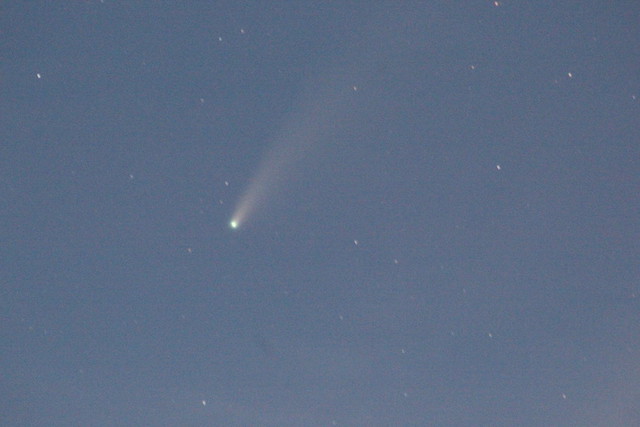Auburn physics professors discuss Comet NEOWISE’s composition, viewing opportunities this week
Article body
Auburn University physics professors Dennis Bodewits and Edward Thomas Jr. have been just as intrigued by the recently visible Comet NEOWISE that has been making headlines the past week as the general public. Bodewits, an associate professor in Auburn’s Department of Physics, and Thomas, the Charles W. Barkley Endowed Professor and associate dean for research and graduate studies in Auburn’s College of Sciences and Mathematics, offer insight into the comet and tips for how locals can get out and see the solar system body before it’s too late.
Comet NEOWISE has been in the news and all over social media recently. Can people in Auburn see the comet, and what is their best chance to see it, as far as time and direction?
Thomas: Comet NEOWISE is currently visible in the northwestern sky for about three hours after sunset, from about 8-11 p.m. It is low in the sky and should be viewed looking in that direction about 15 to 20 degrees above the horizon. It is best viewed with a pair of binoculars or using a camera to take a photo with a five- to 20-second exposure. If it is really dark, it may be visible with the naked eye as a fuzzy object in the sky for another week or two. It is best to head west or south away from the Auburn/Opelika area to get away from the city lights in the evening. Its closest approach to earth will be on July 22, and it should remain visible on clear nights through the rest of July. This link can take people to a database that shows light levels in the area around Auburn and Opelika.
What do you know about this comet's composition and origin?
Thomas: Based upon the available literature, it is a typical comet made of ices and dust. The long, white dusty tail can be seen in many of the photographs. In some very high-resolution photographs online, wave-like structures can be seen in the dust tail.
Bodewits: A second, light blue streak of charged carbon monoxide ions, the so-called ion tail, can also be seen coming from the comet.
How does Comet NEOWISE compare in size or composition to, say, Halley's Comet, and why is it so bright?
Bodewits: The comet is so bright probably not because it is particularly large, but because it got much closer to the sun than most other comets. From images taken by NASA’s Parker spacecraft, scientists have estimated that it has a nucleus that is about 5 kilometers in diameter. This is larger than most comets of this type, but smaller than Halley’s Comet, which is 11 kilometers in diameter.
Can you talk about your research group and the work you're doing these days at the Magnetized Plasma Research Laboratory?
Thomas: Dennis and I are working in close collaboration with Associate Professor Uwe Konopka from the Department of Physics and Assistant Professor Masatoshi Hirabayashi from the Department of Aerospace Engineering on a number of different projects related to “charged dust” and “dusty plasmas” in the laboratory, lunar environment and airless bodies like comets and meteors. In particular, in the laboratory, Professor Konopka and I have studied the behavior of waves in dusty plasmas—called dust acoustic waves—whose properties are believed to be similar to the wave structures that are seen in the tails of comets.
More insight from Bodewits about Comet NEOWISE can be found here.
Auburn University is a nationally ranked land grant institution recognized for its commitment to world-class scholarship, interdisciplinary research with an elite, top-tier Carnegie R1 classification, life-changing outreach with Carnegie’s Community Engagement designation and an undergraduate education experience second to none. Auburn is home to more than 30,000 students, and its faculty and research partners collaborate to develop and deliver meaningful scholarship, science and technology-based advancements that meet pressing regional, national and global needs. Auburn’s commitment to active student engagement, professional success and public/private partnership drives a growing reputation for outreach and extension that delivers broad economic, health and societal impact.







